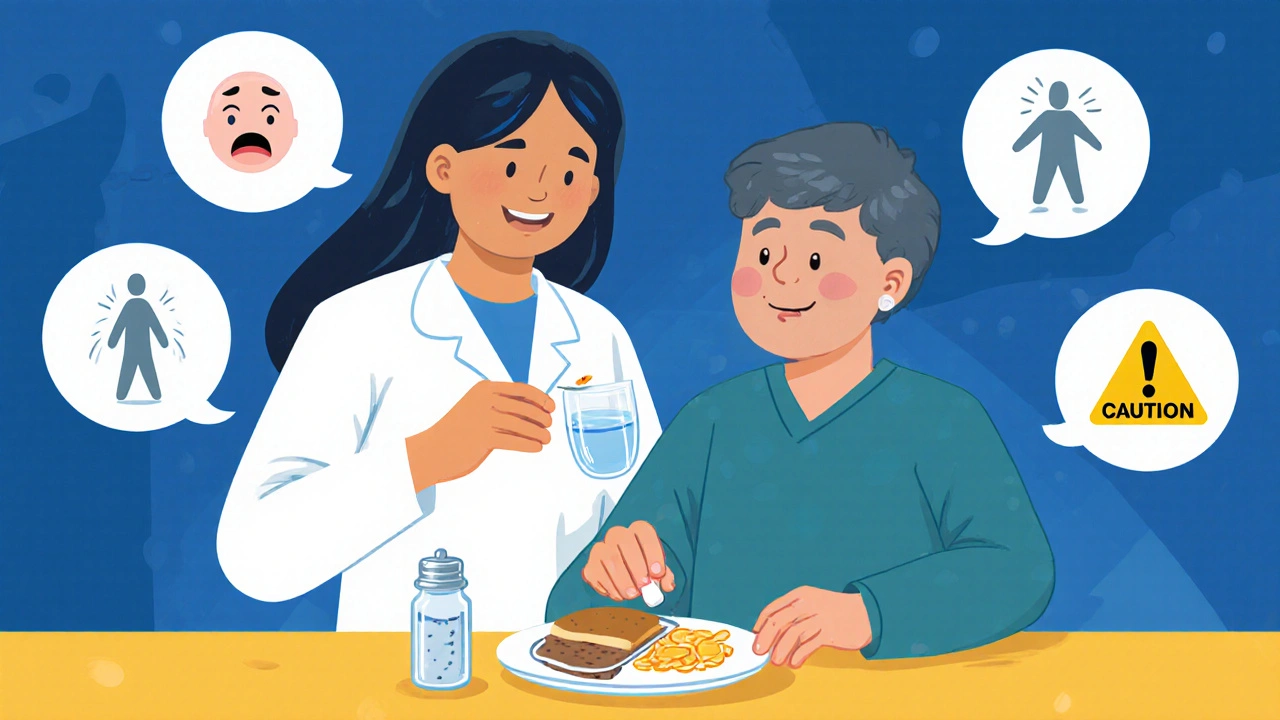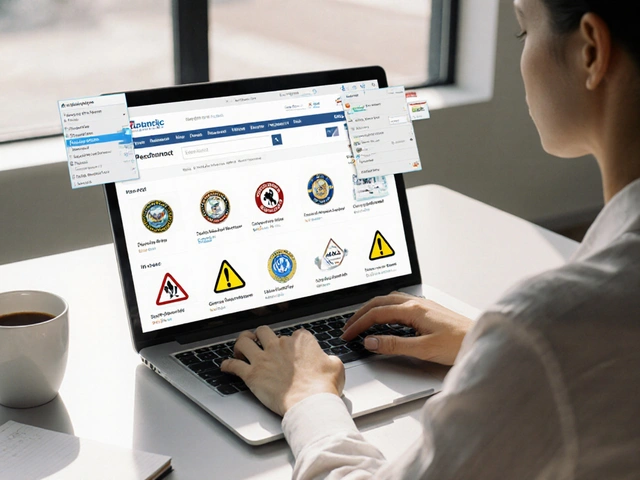
Carbidopa-Levodopa Dose & Symptom Tracker
Dosing Schedule
Side Effect Tracker
Recent Side Effects
Symptom Tracker
Symptom Timeline
Track how your medication schedule correlates with symptom fluctuations to optimize dosing
When treating Parkinson's disease is a progressive neurological disorder that impairs movement and coordination, carbidopa-levodopa is a combination medication that boosts brain dopamine to ease tremor, stiffness, and slowness. It’s the gold‑standard therapy for most patients, but the regimen comes with a handful of practical hurdles. Below are the most common challenges and clear, actionable tips you can start using today.
Why Carbidopa‑Levodopa Works (and What It Consists Of)
Understanding the basics helps you spot problems early. The drug blends two active agents:
- levodopa is a precursor that crosses the blood‑brain barrier and converts into dopamine, the neurotransmitter missing in Parkinson’s.
- carbidopa blocks peripheral conversion of levodopa, letting more of the drug reach the brain and reducing nausea.
Because dopamine spikes and then wanes, timing and dose size become crucial. Missing a dose or taking it too late can trigger “off” periods-times when symptoms flare up unexpectedly.
Common Side‑Effect Pitfalls
Side effects are often the first red flag that something needs tweaking. Here are the most frequent ones and quick fixes:
| Side Effect | Typical Onset | Practical Management |
|---|---|---|
| Nausea & vomiting | First weeks | Take with low‑fat breakfast, split the dose, consider anti‑emetics after consulting a doctor. |
| Orthostatic dizziness | When doses rise | Rise slowly, stay hydrated, add a small amount of salt if approved. |
| Hallucinations | Higher daily totals | Reduce total levodopa, add a MAO‑B inhibitor or adjust nighttime dosing. |
| Impulse control disorders (ICDs) | Long‑term high doses | Screen for gambling, binge eating; discuss dose reduction or switch to a dopamine agonist. |
| Wearing‑off fluctuations | Months to years | Add short‑acting doses, consider extended‑release formulations. |
Mastering the Dosing Schedule
A solid schedule reduces “off” periods and smooths symptom control. Follow these steps:
- Write down every dose time on a wall calendar or phone alarm. Consistency beats perfection-if you’re early, wait a few minutes; if you’re late, take the dose as soon as possible.
- Split the total daily dose into 3-4 equally spaced administrations. For most adults, that means morning, noon, late afternoon, and bedtime.
- Pair each dose with a snack that contains protein‑moderate carbs-protein can compete with levodopa for absorption.
- Track “on” vs. “off” periods in a simple chart (e.g., “Morning 8am - 10am: good; 10am - 12pm: shaky”). This data helps the neurologist fine‑tune the regimen.
When travel or irregular meals disrupt the routine, keep a portable pillbox with compartments labeled for each dose. It’s a lifesaver for caregivers who juggle multiple responsibilities.

Drug Interactions You Can’t Ignore
Some everyday meds or foods can sabotage the therapy:
- High‑protein meals: Large amounts of meat, cheese, or beans can lower levodopa absorption. Aim for protein‑light breakfast and save heftier protein portions for later in the day.
- Antipsychotics (e.g., haloperidol): These block dopamine receptors and may worsen motor symptoms. Discuss alternatives with the prescribing physician.
- Iron supplements: Take at least two hours apart from carbidopa‑levodopa to avoid binding.
- MAO‑B inhibitors (e.g., selegiline): Generally safe, but the combination can increase dopamine levels excessively if doses aren’t balanced.
Keep an up‑to‑date medication list and share it with every healthcare provider you see.
When to Call the Doctor (or Emergency Services)
Not every wobble warrants a trip to the clinic, but certain signs do need prompt attention:
- Sudden, severe confusion or hallucinations that put safety at risk.
- Unexplained falls, especially if they happen repeatedly.
- Persistent nausea that leads to dehydration.
- New onset of severe anxiety, depression, or suicidal thoughts-these may signal dopamine imbalance.
- Rapid worsening of motor symptoms despite a stable dose (could indicate infection or other illness).
For any life‑threatening situation-like choking, severe breathing difficulty, or loss of consciousness-dial emergency services immediately.
Caregiver Toolbox: Practical Tips for Daily Life
Caregivers often become the silent heroes of the therapy. Here are easy habits that make a big difference:
- Medication audit: Once a week, verify that each pill bottle is correctly labeled, not past expiration, and stored at room temperature.
- Hydration reminder: Encourage 6-8 glasses of water daily; dehydration amplifies dizziness and orthostatic drops.
- Exercise buddy: Light to moderate activity (walking, tai chi, swimming) boosts muscle strength and can smooth “on” periods.
- Sleep hygiene: Keep bedtime consistent, dim lights an hour before sleep, and avoid caffeine after noon to reduce nighttime “off” episodes.
- Document everything: Use a simple notebook or app to note doses, side effects, mood changes, and any new meds. This log becomes the conversation starter at each neurologist visit.
Future‑Facing Options: When Standard Therapy Isn’t Enough
If you’ve hit the ceiling of benefit from carbidopa‑levodopa, discuss these alternatives with a movement‑disorder specialist:
- Extended‑release formulations: Provide steadier dopamine levels over 12-24hours.
- Continuous infusion (Duodopa or levodopa‑carbidopa intestinal gel): Bypasses erratic gut absorption.
- Deep brain stimulation (DBS): Surgical option for severe motor fluctuations.
- Adjunctive oral meds: Add a dopamine agonist or a COMT inhibitor to smooth peaks and troughs.
Each option carries its own risk profile, so weigh benefits against possible complications with your care team.
Frequently Asked Questions
Can I take carbidopa‑levodopa with coffee?
Moderate caffeine (one cup of coffee) is usually fine, but large amounts can increase tremor in some people. If you notice worsening symptoms after coffee, cut back and discuss with your doctor.
Why does protein affect my medication?
Levodopa uses the same transport system in the gut as large neutral amino acids found in protein. A protein‑heavy meal can out‑compete levodopa, lowering the amount that reaches the brain.
What’s the difference between short‑acting and extended‑release pills?
Short‑acting tablets start working within 30minutes but wear off after 3-4hours, requiring multiple doses a day. Extended‑release tablets release levodopa more slowly, lasting 8-12hours, which can reduce “off” periods and simplify the schedule.
Should I stop the medication if I feel nauseous?
Never stop abruptly. Instead, take the dose with food, split it into smaller portions, or ask your neurologist about adding an anti‑emetic. Sudden discontinuation can cause a rapid worsening of motor symptoms.
How often should I see my neurologist?
Most patients schedule a visit every 6‑12months, but if you notice new side effects, worsening of “off” periods, or need to adjust doses, call sooner.
By staying organized, watching for side effects, and keeping open communication with the care team, patients and caregivers can turn carbidopa‑levodopa from a source of uncertainty into a reliable tool for daily living. Remember, the goal isn’t just to take a pill-it’s to keep moving forward with confidence.
Write a comment
Your email address will not be published.





16 Comments
Great rundown! I’ve found that pairing the morning dose with a light toast and a bit of jam really cuts down the nausea. Setting an alarm on your phone works wonders for consistency, especially on weekends when the routine drifts. Also, keep a tiny notebook handy to jot down any “off” spikes-you’ll thank yourself at the next doctor visit.
Thanks for the tip! I’d add that splitting the total daily dose into three equal parts can smooth out those fluctuations. A quick glance at the pharmacy label helps you double‑check the timing. If a dose is missed, taking it as soon as you remember (but not doubling up) usually prevents a big “off” swing. Staying hydrated and avoiding high‑protein meals right before dosing also makes a noticeable difference.
Life is a series of peaks and valleys, much like the dopamine tides our meds try to tame. When the pill wears off, it feels like a curtain dropping on the stage of our day. Yet within that darkness, there’s a strange clarity-a reminder that we’re more than just chemistry. So I say, ride the wave, watch the off‑times, and let the rhythm guide you.
That’s a poetic way to look at it, and it resonates with many of us navigating Parkinson’s. The key is to accept the ebb while staying proactive about the flow. Using a simple mood‑tracker can help you see patterns you might otherwise miss. Remember, you’re not alone in this dance; the community is here to support each step.
It is essential to recognize that carbidopa‑levodopa therapy demands meticulous scheduling to achieve optimal motor control. First, document each administration time in a dedicated log, noting the onset and duration of “on” periods. Second, coordinate meals with low‑protein content at breakfast to enhance absorption, reserving protein‑rich foods for later in the day. Third, advise caregivers to monitor orthostatic blood pressure and adjust fluid intake accordingly. Fourth, evaluate the need for adjunctive agents such as COMT inhibitors when wearing‑off phenomena emerge. Fifth, schedule neurology follow‑ups at six‑month intervals, or sooner if adverse events arise. Sixth, consider extended‑release formulations for patients experiencing frequent dose‑related peaks. Seventh, maintain an up‑to‑date medication reconciliation list to prevent harmful interactions.
The aforementioned protocol, while ostensibly comprehensive, suffers from an underappreciation of pharmacokinetic variability inherent in levodopa metabolism. One must interrogate the bioavailability coefficients and assess the substrate competition posed by dietary amino acids. Moreover, the clinical ramification of orthostatic hypotension necessitates a hemodynamic stratification framework. In practice, the therapeutic index is narrow, prompting a need for dose titration algorithms calibrated to patient‑specific response curves. Ultimately, a multidisciplinary approach leveraging neuropharmacology expertise is indispensable.
Oh sure, just pop a pill and magically become a ninja dancer-because that’s how medication works. If you’re hoping for a miracle, you might be better off buying a crystal. Reality check: even the best regimen needs patience and a solid support system.
Wow!! This is sooo helpful!! I totally agree!! Make sure u set alarums on your phone!!! And keep a pillbox near the coffee mug!! It makes a big diffrence!!
While the article presents a useful overview, it overlooks several pivotal pharmacodynamic considerations. For instance, the interaction between levodopa and high‑density protein sources warrants a quantitative analysis of amino‑acid competition. Additionally, the timing of iron supplementation should be rigorously separated by at least two hours to prevent chelation. The omission of such details may lead to suboptimal therapeutic outcomes. 📈📚
Good points, Karthik. I’d also suggest adding a quick reference table for common drug‑food interactions-makes it easier for caregivers to spot pitfalls. Sharing a printable schedule can empower patients to stay on track. Let’s keep building resources that are both science‑backed and user‑friendly.
In many South Asian households, meals are protein‑rich and often shared at midday, which can unintentionally interfere with levodopa absorption. Adjusting the medication schedule to occur before the main meal, or choosing low‑protein snacks, can respect cultural dining practices while preserving efficacy. Encouraging caregivers to involve family members in the timing plan fosters communal support. Moreover, incorporating gentle yoga or mindfulness sessions can complement the pharmacologic regimen by reducing stress‑induced tremors.
I appreciate the cultural insights, Ashika. A modest reminder: even a brief note in a daily planner can bridge the gap between tradition and treatment. Small, consistent actions often yield the biggest gains.
Timing is everything. Missed doses can undo weeks of progress.
When we speak of medication adherence, we are really discussing the choreography of daily life, a performance in which every cue matters. The first act begins with the sunrise, when the patient rises, stretches, and reaches for the pill as if it were a baton directing the ensemble. The second act unfolds during the mid‑day, where the clash between a hearty protein dinner and the drug’s absorption becomes a dramatic tableau of competition for transporters. In the third act, the evening dose serves as a gentle lullaby, coaxing the brain into a smoother “on” state before sleep. Each intermission, be it a doctor’s appointment or a family gathering, provides an opportunity to reassess the script and make necessary edits. The caregivers, often unnoticed, are the stage managers, ensuring that props-pillboxes, alarms, water glasses-are in place. Their patience, like a well‑timed cue, prevents a stumble that could send the patient into an “off” tumble. Moreover, the literature reminds us that orthostatic dizziness is not merely a physiological hiccup but a signal that the script has lost its rhythm. Hydration, a simple yet powerful prop, re‑establishes the balance as effectively as any pharmacologic adjustment. Food, too, plays a role; by shifting protein‑heavy meals to later in the day, we give levodopa a clearer runway to the brain. The nuanced dance of dosage splitting is akin to dividing a complex symphony into manageable movements. When the patient feels the “wear‑off” and the music wanes, adding a short‑acting dose can revive the melody without causing a discordant crescendo. Documentation, often dismissed as bureaucratic, acts as the score that clinicians read to fine‑tune the therapy. A handwritten log may seem antiquated, yet it captures the subtle variations that electronic data sometimes smooths over. In essence, the art of managing carbidopa‑levodopa is a collaborative composition between patient, caregiver, and clinician, each contributing a distinct instrument to the orchestra. When every note is in place, the result is not just symptom control but a harmonious life.
Nice deep dive! I love the practical tips, especially the reminder to keep water handy 😊 It's the small things that keep us steady on tough days.
Short but spot on.